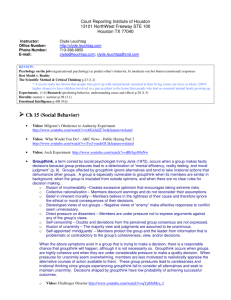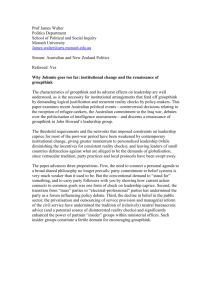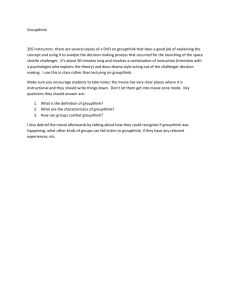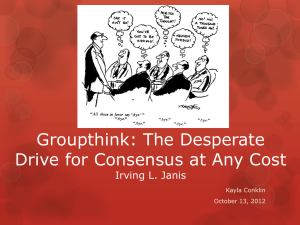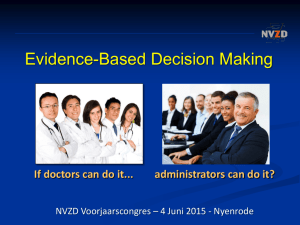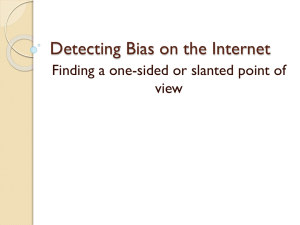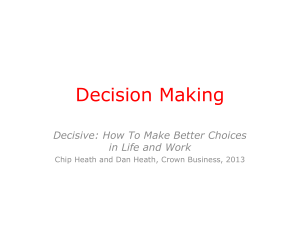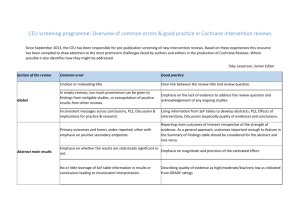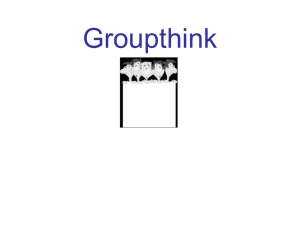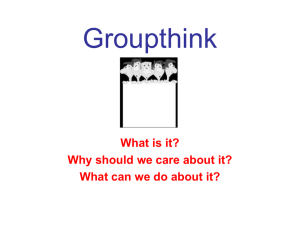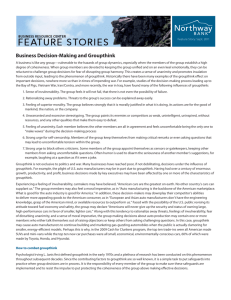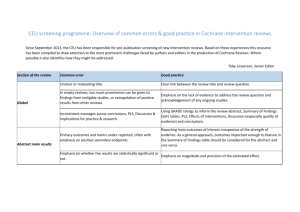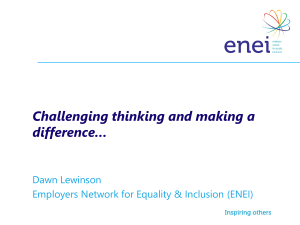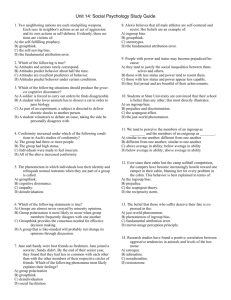11 Decision Making - team7
advertisement
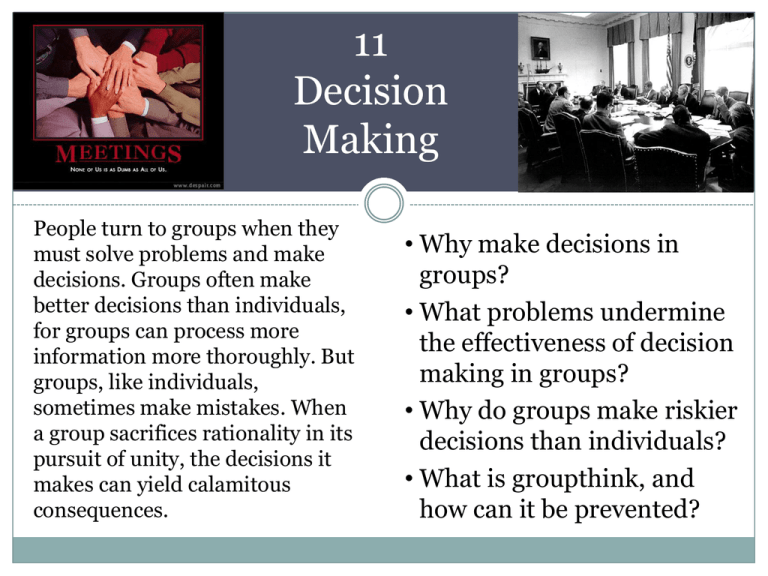
11 Decision Making People turn to groups when they must solve problems and make decisions. Groups often make better decisions than individuals, for groups can process more information more thoroughly. But groups, like individuals, sometimes make mistakes. When a group sacrifices rationality in its pursuit of unity, the decisions it makes can yield calamitous consequences. • Why make decisions in groups? • What problems undermine the effectiveness of decision making in groups? • Why do groups make riskier decisions than individuals? • What is groupthink, and how can it be prevented? Decision Making The mob has no judgment, no discretion, no direction, no discrimination, no consistency. Cicero madness is the exception in individuals but the rule in groups. Nietzsche When "a 100 clever heads join a group, one big nincompoop is the result.” Carl Jung Decision Making in Groups Why Work in Groups? more people = more information groups can discuss, process information (check for errors, etc.) more people to do more work groups have standards for deciding (e.g., majority rules) more people means people can do what they are best at people are more likely to follow through if part of a group that decided Why Not? sometimes the group doesn't recognize the correct problem, even if proposed discussion can be manipulated groups oversample shared information groups sometimes make riskier decisions sometimes work done by just a few groups sometimes make horrible decisions when very cohesive (groupthink) Defining the Problem Orientation Orientation Discussion No Decision Reached Decision Decision Reached Implementation Planning the Process Functional Model of Decision Making Orientation Development of shared mental model Tendency to skip this step Remembering Information Discussion Exchanging Information Processing Information Remembering information Exchanging information: Acquiring and sharing data Processing information: Collective review of information • collective memory • weakness in group memory • cross-cueing • transactive memory Decision: Social decision schemes Decision Ways to Make the Decision Delegation Statistical aggregation Voting Consensus (discussion to unanimity) Random choice Decision Reached Implementation Evaluating the Decision Adhering to the Decision Implementation Evaluating the decision Adhering to the decision: Coch and French (1948) Vroom’s normative model of decision making Vroom’s normative model of decision making Consult (Individual): Decide: Leader makes decision Leader discusses with individual members, then makes decision him or herself Consult (Group): Leader discusses with group, but makes decision him or herself Facilitate: Leader coordinates problem solving session Delegate: Leader turns problem over to the group Enron Denver Airport Abilene paradox 1.7 billion – 300 million Which is not to say that groups always make good decisions What Problems Undermine the Effectiveness of Decision-Making Groups? Discussion is Difficult Group discussion pitfalls • Information processing limitations: leveling, assimilation, sharpening • Poor communication skills • Decisional avoidance (procrastination, bolstering, satisficing) Shared Information Bias Oversampling shared information leads to poorer decisions when a hidden profile would be revealed by considering the unshared information more closely Causes Informational influence Normative influence Emphasis on consensus vs. correctness Initial preferences Impression management goals Reducing the Shared Information Bias The SIB can be reduced by improving information exchange by: 60 50 40 F-to-F GDSS 30 Good leadership Increasing diversity Using a GDSS (group decision support system) 20 10 0 Pre Post Discussion Judgmental Errors of Omission, Commission, and Imprecision “Sin” of Commission of Omission Examples Belief perseverance: reliance on information that has already been reviewed and found to be inaccurate Sunk cost bias: reluctance to abandon a course of action once an investment has been made in that action Extra-evidentiary bias: use of information that one has been told explicitly to ignore Hindsight bias: tendency to overestimate the accuracy of prior knowledge of an outcome Base rate bias: failure to pay attention to information about general tendencies Fundamental attribution error: stressing dispositional causes when making attributions about the cause of people’s behaviors of Availability heuristic: basing decisions on information that is readily available Imprecision Conjunctive bias: failing to recognize that the probability of two events occurring together will always be less than the probability of just one of the events occurring Representativeness heuristic: excessive reliance on salient but misleading aspects of a problem Polarization and Risk Group polarization: A shift in the direction of greater extremity in individuals' responses Why Do Groups Make Riskier Decisions than Individuals? Social comparison theory Persuasivearguments theory “Risk-supported wins” social decision scheme Janis’s Theory of Groupthink Kennedy’s advisory group planning the Bay of Pigs “covert op” Causes Groupthink: Causes Cohesion StructuralFaults Provocative Situational Context Symptoms Overestimation of the group • illusions of invulnerability • illusions of morality Close-mindedness • rationalizations • stereotypes about the outgroup Pressures toward uniformity. • • • • Defective decisionmaking processes self-censorship, the illusion of unanimity direct pressure on dissenters self-appointed mindguards) Abilene paradox Sunk costs How Can Groupthink Be Prevented? Limiting premature seeking of concurrence • Open style of leadership • Devil’s advocate, subgroup discussions Correcting misperceptions and biases Using effective decision-making techniques
